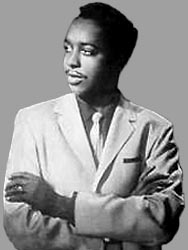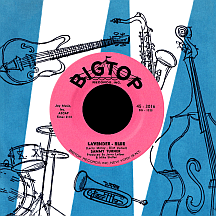SAMMY TURNER
Lavender-Blue
Johnny Bienstock started the Bigtop label in 1958 as a recording arm of Hill and Range music publishers. In no time he chalked up a minor hit with Bobby Pedrick, Jr.'s "White Bucks and Saddle Shoes," then a few months later the company's breakthrough hit came rushing in from out of the not-too-distant past, the kind of thing The Platters ("My Prayer," "Smoke Gets in Your Eyes") had turned into million sellers. "Lavender Blue (Dilly Dilly)," a light, Oscar-nominated, youth-appeal film tune from Walt Disney's 1949 live-action-boy-meets-animated-lamb tale So Dear to My Heart, was the song chosen for an overhaul. Bigtop had already recorded a singer Bienstock considered on a par with Platters lead Tony Williams and big '58 star Tommy Edwards; the appealing voice of Sammy Turner set against a Jerry Leiber-Mike Stoller production featuring a lush orchestra and sentimentally sweet-sounding backing singers made "Lavender-Blue" one of the hottest hits of 1959.
Turner, born Samuel Black in 1932, grew up in Paterson, New Jersey and developed an interest in singing and songwriting at an early age. When the Korean War began in 1950 he put his dreams on hold and enlisted in the U.S. Air Force, later serving active duty as a paratrooper. Afterwards Sammy returned to Jersey and worked as an accounting clerk, moonlighting on weekends as a nightclub singer. He was spotted by longtime record promoter and music manager Herb Lutz, who was looking for a guy who could pull off some of the old standards Herb had loved and, in some cases, helped develop the first time around. Atlantic Records showed some interest, but Bienstock offered a better percentage and Sammy turned up on Bigtop's doorstep. Either way, he wouldn't have missed out on working with hitmakers Leiber and Stoller.
For his first release, the label matched him with an R&B studio group that had already used a few different names including The Lamplighters and The Sharps; at the time, the quartet consisted of Carl White, Al Frazier, Sonny Harris and Rocky Wilson. The five-man team, with Sammy Black-turned-Turner its lead singer, tackled "Annie Laurie," an 18th century poem written William Douglas with a melody by Alicia Scott that had been a hit in 1910 for Irish tenor John McCormack. Nearly five decades later, the melody had been updated by songwriter Rita Murphy, the titled was expanded to "Sweet Annie Laurie" and the resultant Leiber-Stoller production by Sammy Turner and the Twisters made an ever-so-brief chart appearance in March of '59. Afterwards Sammy was strictly a solo act and the Twisters went on to have their greatest success in the '60s as the "Papa-Oom-Mow-Mow"-in' Rivingtons.
Johnny B. was convinced the moldy-oldie-remake formula would work for Turner. These types of sentimental songs were a 180-degree turn from the material Leiber and Stoller usually had success with (by Atlantic's Drifters, Atco's Coasters, "Big Mama" Thornton and the like), though the producing pair hadn't hidden their desire to follow a less-gimmicky route. "Lavender Blue" (pre-hyphen) was more recent at least, a Larry Morey-Eliot Daniel song that had been performed by Burl Ives in the Disney film. Three early-'49 cover versions turned up on the charts; the biggest by bandleader Sammy Kaye and his girl singers The Three Kaydets, another by '40s superstar Dinah Shore, with recordings by Jack Smith and The Clark Sisters bringing up the rear.

Sammy's smooth rendition topped them all, but only after considerable effort on the part of Bienstock. Dick Clark didn't like the song (he said he'd worked with a guy ten years earlier who sang "Dilly Dilly" all the time and it drove him nuts!) but promised he'd spin it on American Bandstand's turntable if Johnny could get it played on another station in Philadelphia, AB's base of operations. Despite the song's pop sound, he convinced R&B station WDAS to add it; reaction was positive and soon the city's top 40 outlet, WFIL, got in on the action. Clark kept his promise, the nationwide exposure did the trick and "Lavender-Blue" became a giant hit, rising to number three in August '59. Once it was firmly established as a breakout smash for Bigtop Records, executives at Hill and Range, the label's principle financial owner, expressed disappointment that the song wasn't one they owned the copyright to. Johnny defended his position, taking the stance that a hit is a hit and you can't always have your cake and eat it too.
Convinced the pop remakes were the best fit for Turner and considering the success he'd had, he kept digging up overripe chestnuts for the singer to turn into gold. Irving Berlin's "Always" had been a hit for several artists in 1926, foremost among them a pair of stalwart bandleaders who took the tune to number one: Portland, Oregon-born George Olsen (with vocalists Fran Frey, Bob Rice and Edward Joyce) and Brooklyn's Vincent Lopez, whose instrumental was the biggest hit of his career. Sammy Turner's interpretation is worlds away from these '20s waltzes, with saxophonist King Curtis in fine form delivering some low, punchy sax riffs (quite different from his usual "yakety" sound on so many Coasters classics). "Always" was a top 20 pop hit and even bigger rhythm and blues hit, reaching number two in mid-December, held off the top spot by "So Many Ways," one of many hits for another peer balladeer, Brook Benton. The flip side, "Symphony," previously a popular song in 1946 by multiple artists (chief among them Freddy Martin with vocalist Clyde Rogers, who took it to number one), had its share of followers as Sammy's version spent a few weeks on the charts. Overall, 1959 was a peak year for Leiber and Stoller; they produced more than a dozen hits, most of which they also composed, in addition to Wilbert Harrison's chart-topping "Kansas City" and Turner's two smashes.
Sammy turned out yet another oldtime remake in early 1960 with "Paradise" (penned by Nacio Herb Brown and Gordon Clifford), which had topped the charts in 1932 by two acts, Leo Reisman (with vocalist Frances Maddux) and Guy Lombardo. Then his fortunes took an abrupt about-turn. Seven successive Bigtop singles failed to connect; "Love Keeps Calling," in mid-'61, was the last to garner airplay in a few random cities. "Raincoat in the River," from later in the year, is worthy of mention for two reasons: it was produced by Phil Spector just before he started his own successful Philles label and it was Turner's final Bigtop single. A couple of years passed, then Motown gave him a shot; "Only You," sounding somewhere between the Platters' original and Turner's own "Lavender-Blue," reveals the similarity between Sammy's and Tony Williams' voices that Herb Lutz heard at the start. The label also promoted the B side, "Right Now," but neither song clicked. It was his only Motown release.
His experience at Detroit's top company led to other Motor City recording sessions, resulting in one single on 20th Century-Fox in 1965. The following year, Teddy Randazzo produced him for Verve Records; "Our Love Will Grow and Grow" was reviewed by Billboard magazine in August 1966 (they said it "should prove a top-of-the-chart item," an unfortunately inaccurate prediction). Sammy worked with soul singer George Kerr in the late 1960s and composed "My Heart Needs a Break" for Linda Jones, a strong effort produced by Kerr. In the '70s, Turner worked as a background singer, contributing to albums by Donny Hathaway (his self-titled 1971 set), Roberta Flack (Quiet Fire, 1971) and Aretha Franklin (Young, Gifted and Black, 1972). He emerged again in 1978 with a smooth, jazzy soul song, "Do You Know (What Life is All About)." He and Kerr also contributed backing vocals to Joan Armatrading's top-selling 1980 album Me Myself I. All in all, Sammy Turner turned out a fine body of work...and was fortunate enough to have a phrase (in this case the endearingly silly "Dilly Dilly") that he'll always be remembered for.


